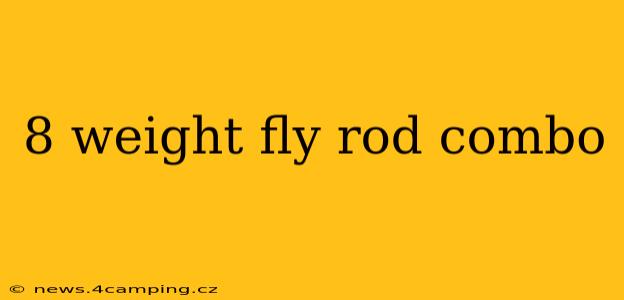Choosing the right 8-weight fly rod combo can significantly impact your fishing experience. This comprehensive guide will help you navigate the options, understand the key features, and select the perfect setup for your angling adventures. Whether you're targeting bonefish in the flats, battling powerful tarpon, or chasing salmon in rivers, an 8-weight rod offers versatility and power for a wide range of species and fishing conditions.
What is an 8-Weight Fly Rod Used For?
An 8-weight fly rod is a versatile choice, suitable for a broad spectrum of fish and fishing situations. Its power and strength make it ideal for tackling larger, more powerful fish. Here are some common applications:
- Saltwater Species: Bonefish, redfish, snook, permit, striped bass, and even smaller tarpon. The extra power helps you effectively manage the strong runs and powerful jumps of these saltwater species.
- Freshwater Species: Largemouth bass, pike, muskie, and salmon (depending on the river size and conditions). While an 8-weight might be overkill for smaller bass, it excels when targeting trophy-sized fish in challenging environments.
- Larger Flies: The robust nature of the 8-weight allows you to comfortably cast larger flies, including streamers, poppers, and other bulky patterns often required for bigger fish.
What Makes a Good 8-Weight Fly Rod Combo?
A truly exceptional 8-weight fly rod combo is more than just the rod itself; it's a harmonious system of rod, reel, and line working in perfect synergy. Here's a breakdown of the crucial elements:
The Rod: Power, Action, and Material
- Power: 8-weight rods are typically classified as medium-heavy to heavy in power. This indicates their ability to cast heavier lines and handle strong fish.
- Action: The action describes the rod's flex pattern. Faster actions are stiffer and offer more power for long casts and fighting fish, while slower actions are more forgiving and provide better feel and accuracy at closer ranges. Your choice will depend on your personal casting style and preferred fishing situation.
- Material: Graphite is the most common material for fly rods, offering a lightweight yet powerful build. Higher-quality graphite blends usually result in a more sensitive and responsive rod.
The Reel: Capacity and Drag System
- Capacity: The reel must have sufficient capacity to hold a sufficient amount of backing and fly line for extended fights with large fish. Check the reel's specifications to ensure it's compatible with your chosen 8-weight line.
- Drag System: A smooth, reliable drag system is crucial for controlling powerful fish. Look for reels with a sealed drag system to prevent saltwater intrusion, especially if you're fishing in saltwater environments.
The Line: Weight and Type
- Weight: The line weight should match the rod's weight (8-weight). Using an incorrect line weight can negatively affect your casting performance and rod's lifespan.
- Type: The choice of line type depends on your fishing style and target species. Weight-forward lines are excellent for long casts and distance, while shooting heads are ideal for long-range presentations. Consider the type of water you'll be fishing (e.g., fast-flowing rivers vs. calm flats) when selecting a line.
What are the Best 8-Weight Fly Rod Combos?
There's no single "best" combo, as the ideal choice depends on individual preferences and budget. However, several reputable brands consistently produce high-quality 8-weight setups. Researching reviews and comparing features from brands like Sage, Orvis, G. Loomis, and others is highly recommended. Consider factors like rod action, reel drag system, and overall balance when making your selection.
H2: What is the difference between a 7-weight and an 8-weight fly rod?
The difference primarily lies in power and line weight. An 8-weight is noticeably stronger and throws heavier lines, making it suitable for larger fish and more challenging conditions. A 7-weight is a step down in power and is better suited for smaller fish and lighter lines. The choice depends on the target species and the average size of the fish you expect to encounter.
H2: How much line should I have on my 8-weight fly reel?
You should have enough backing to allow for a long fight with a large fish, followed by your fly line. The amount of backing needed depends on the reel's capacity and the size of fish you're targeting. Check your reel's specifications to determine the recommended backing and fly line amount. Generally, you want enough backing to allow for many long runs without the fish stripping your line entirely.
H2: How do I choose the right fly line for my 8-weight rod?
The fly line should match the rod's weight rating (8-weight). Beyond that, consider the type of line: weight-forward lines are versatile for many situations, while shooting heads excel at distance casting. Consider the environment you'll be fishing – a fast-flowing river requires a different line than calm flats.
H2: How often should I maintain my 8-weight fly rod combo?
Regular maintenance is key to extending the life of your gear. After each fishing trip, rinse your rod and reel with fresh water to remove saltwater or debris. Periodically lubricate the reel's drag system and inspect the rod for any damage. Store your rod in a protective case when not in use.
By carefully considering these factors and investing in a high-quality 8-weight fly rod combo, you'll be well-equipped to tackle a wide variety of fishing challenges and land the catch of a lifetime. Remember that personal preference plays a significant role, so don't hesitate to test different rods and reels before making a final decision.
